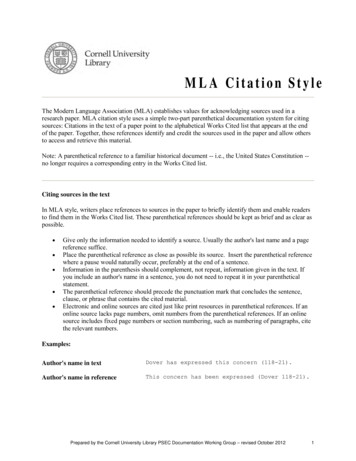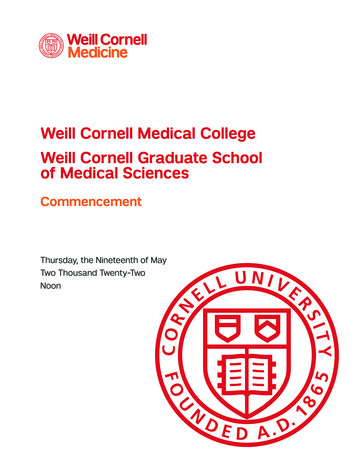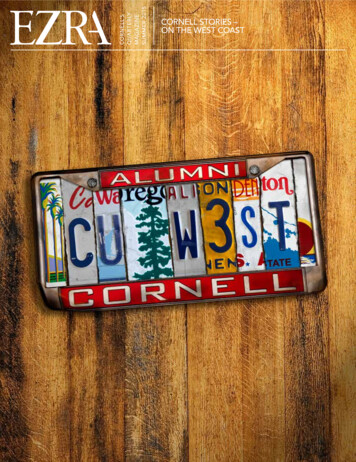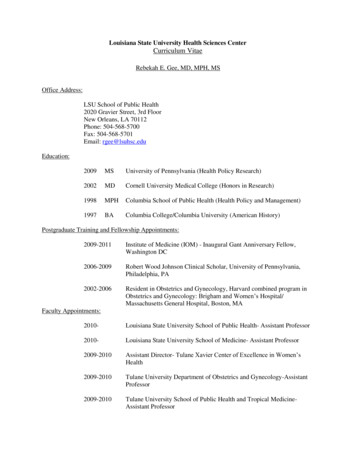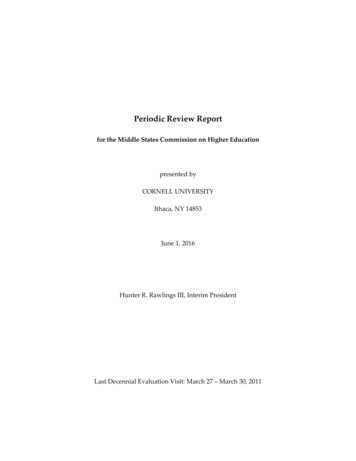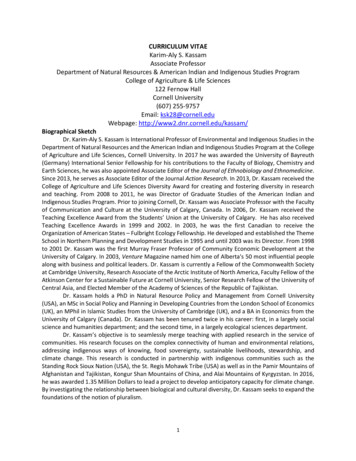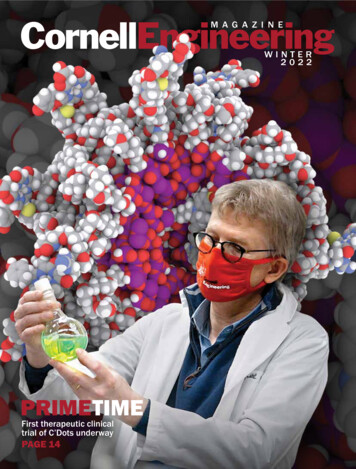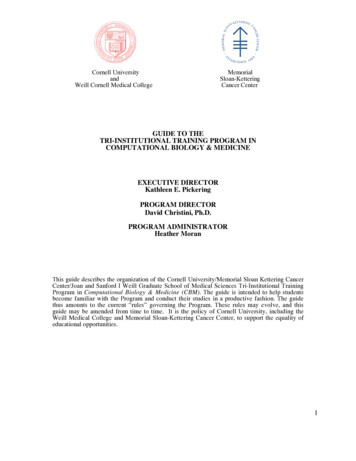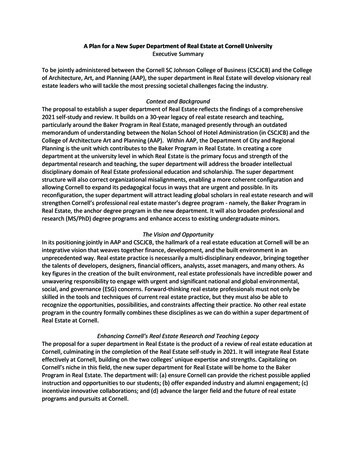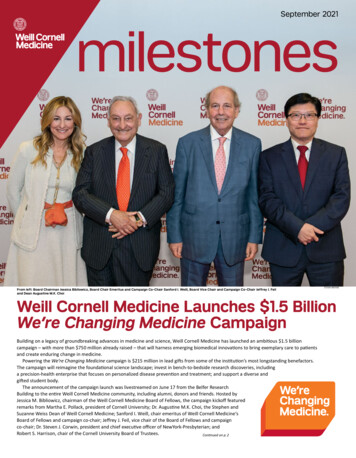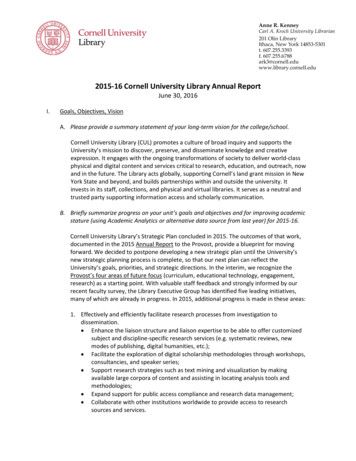
Transcription
Anne R. KenneyCarl A. Kroch University Librarian201 Olin LibraryIthaca, New York 14853-5301t. 607.255.3393f. u2015-16 Cornell University Library Annual ReportJune 30, 2016I.Goals, Objectives, VisionA. Please provide a summary statement of your long-term vision for the college/school.Cornell University Library (CUL) promotes a culture of broad inquiry and supports theUniversity’s mission to discover, preserve, and disseminate knowledge and creativeexpression. It engages with the ongoing transformations of society to deliver world-classphysical and digital content and services critical to research, education, and outreach, nowand in the future. The Library acts globally, supporting Cornell’s land grant mission in NewYork State and beyond, and builds partnerships within and outside the university. Itinvests in its staff, collections, and physical and virtual libraries. It serves as a neutral andtrusted party supporting information access and scholarly communication.B. Briefly summarize progress on your unit’s goals and objectives and for improving academicstature (using Academic Analytics or alternative data source from last year) for 2015-16.Cornell University Library’s Strategic Plan concluded in 2015. The outcomes of that work,documented in the 2015 Annual Report to the Provost, provide a blueprint for movingforward. We decided to postpone developing a new strategic plan until the University’snew strategic planning process is complete, so that our next plan can reflect theUniversity’s goals, priorities, and strategic directions. In the interim, we recognize theProvost’s four areas of future focus (curriculum, educational technology, engagement,research) as a starting point. With valuable staff feedback and strongly informed by ourrecent faculty survey, the Library Executive Group has identified five leading initiatives,many of which are already in progress. In 2015, additional progress is made in these areas:1. Effectively and efficiently facilitate research processes from investigation todissemination. Enhance the liaison structure and liaison expertise to be able to offer customizedsubject and discipline-specific research services (e.g. systematic reviews, newmodes of publishing, digital humanities, etc.); Facilitate the exploration of digital scholarship methodologies through workshops,consultancies, and speaker series; Support research strategies such as text mining and visualization by makingavailable large corpora of content and assisting in locating analysis tools andmethodologies; Expand support for public access compliance and research data management; Collaborate with other institutions worldwide to provide access to researchsources and services.
Cornell University Library Annual Report 2015-1622. Advance the visibility and accessibility of Cornell scholarship and creative expression. Participate in campus efforts to evaluate and pilot tools to track research,scholarship, and creative outputs and to create a University-wide system formanaging research information; Develop the Library’s semantic web and identity management expertise to helpfaculty, units, and the University broaden research visibility and use; Build a Scholars@Cornell portal that helps ensure the visibility of Cornell'sresearch and scholarship, aids in faculty recruiting, and enhances opportunities forinterdisciplinary research and collaboration; Provide services and advice to faculty to protect their intellectual property andensure the widest possible dissemination and visibility of their scholarship; Increase the Library’s presence in campus initiatives seeking new ways to makescholarship visible and accessible, including through open access options; Document the University’s scientific, scholarly, and creative work and its impacton the world at large.3. Prepare students to effectively use and produce knowledge in a digital world. Work with other academic and service units (e.g., the Office of SponsoredPrograms, Academic Technologies, the Center for Teaching Excellence, Office ofUndergraduate Research, Graduate School) to identify gaps and opportunities insupport for new forms of technology-enabled research, teaching, and learning; Expand support for the growing set of 21st century competencies (e.g., visual,data, and information research workflows); Ensure that library instruction will facilitate and enable technology-enhancedpedagogies and active learning on campus, online, and around the globe; Leverage and build library staff expertise to increase student and facultyparticipation in the production, dissemination, and preservation of knowledge inthe digital age; Offer graduate student fellowships and training/consulting in research datamanagement, digital humanities tools and methodologies, new forms ofpublishing, etc.4. Enhance the Library’s Support for the University’s international goals. Enhance Cornell’s global collections and expertise to support study and researchhere and abroad, including dual-degree programs in other countries; Develop more domestic and international library partnerships that expand accessto onsite collections and subject expertise around the globe, wherever Cornellfaculty and students can be found; Continue the Library’s international engagement to strengthen local informationinfrastructures, disseminate and preserve scholarly resources and scholarship hereand abroad, and document Cornell’s impact worldwide; Increase the Library’s presence through outreach to campus units andengagement with international student organizations on campus, andinternational alumni groups.
Cornell University Library Annual Report 2015-1635. Preserve Cornell’s digital assets and scholarship for future generations of scholars andstudents. Align various preservation strategies to create an integrated serviceframework to reduce duplicative effort, identify service gaps, and increaseefficacy. Consider how our investments in various digital repositories,including the Cornell University Library Archival Repository (CULAR), as wellas HathiTrust, LOCKSS, Portico, and Archive-it, meet our preservation needs; Engage the Library’s curators/selectors in setting priorities for long-termarchiving and delineate categories of commitment and levels of preservationand long-term access to be achieved. Work closely and cross-departmentally(DSPS, RMC, Kheel, etc.) to understand short- and long-term needs withregards to digital content and co-create best practices for the managementof digital resources; Create a web archiving strategy in support of web resource curation,collection, and preservation; Develop a model to anticipate costs and staffing needs associated with thepreservation goals and recommend models for supporting such a serviceframework through central funding allocations and cost-recovery models; Analyze the recently completed campus-wide AV survey in order torecommend and implement strategies associated with AV content and largedata sets.C. Provide updated goals and objectives and plans for improving academic stature for 201617.1. The Library has always provided Cornell researchers with privileged access toscholarly literature and other information resources by building exceptionally wideand deep collections and developing outstanding services to support the productionof new scholarship and public knowledge. CUL will continue to build digital andphysical collections that are tailored to Cornell’s established and emerging fields ofinquiry and optimized – in format, functionality, and license terms – for a full rangeof research methods. Current changes in technology and external researchrequirements open up both new opportunities and present challenges in the wayresearch is produced, shared, preserved, and archived for future generations.2. Coherent strategies for managing Cornell’s reputation are crucial to securing researchfunding, recruiting top students and faculty, and building relationships with alumniand other stakeholders.3. Historically, Cornell’s administrative offices tracked, managed and reported faculty’sresearch and output. Today, that mission has grown more complex. It is critical to theUniversity’s reputation and to faculty recruitment and success that Cornell’s work canbe discovered and accessed worldwide. The Library has deep expertise in identifying,organizing, and publicizing scholarly work, as well as making it accessible. Thisexpertise is increasingly valuable to the University and its researchers as they competefor external funding and name recognition in an increasingly competitiveenvironment.
Cornell University Library Annual Report 2015-1644. The powerful forces transforming higher education call for deeper library engagementin the entire academic experience. Technological advances and major shifts towarddigital production and distribution are changing research, teaching and learning.Students will need concomitant skills as they leave Cornell to pursue jobs, additionaleducation, and public service.5. The Library has invested heavily in digitizing collections and curating born-digitalcontent and we need to ensure that this content will be usable now and in the future.The Library began collecting Cornell-related sites, including the cornell.edu webdomain, in June 2012, representing more than 5 TB of information. The Library alsoanticipates greater demand for managing data associated with federally-fundedresearch projects. Given the increasing reliance on digital sources and applications, weare projecting a substantial increase in our scholarly digital assets, estimated at 100TB/year. The need for a comprehensive preservation program has grown with demandand with the development of new technological capabilities.The University Strategic Planning is impacted by the untimely passing of President Garrett.In 2016-2017, the Library will continue moving the above goals forward. Library staffcontinuously build research-level collections, and develop specialized services across thefull disciplinary spectrum. We have built expertise to work with humanists to use newdigital research tools and methodologies; to work with scientists and social scientists tomanage large data sets and comply with regulatory requirements; and to work with artistsand others to create, share, and preserve new media art forms. Our support of openaccess provides critical scholarship to Cornell, U.S., and rest of developing countries, andincreased visibility to Cornell University research.The above five leading issues represent efforts in process. The next two years will be usedto further this work, to knit together the various efforts across the system, and tocontinue to strengthen the Library’s position as an essential component in the evolving21st century academic infrastructure.II.Academic Program PlanningDescribe plans for new degree programs and online learning, executive education, andcertificate programs.Not applicableIII.Toward New DestinationsA. TND 2015-16 Outcomes: In this section, you will summarize the outcomes to date of theinitiatives your college or administrative unit submitted in June 2015. This should include adescription of the actions you took and any quantitative or qualitative results. Please bebrief, yet detailed.
Cornell University Library Annual Report 2015-165The Library has implemented all three of our diversity initiatives for 2015-2016.1. Two-year minority fellowship in the Law Library. After a national search to hire anunderrepresented minority as a librarian, we appointed Malikah Hall, an AfricanAmerican female, to a two-year position at the Law Library.2. Facilitated discussions to engage staff in discussion of workplace inclusion. LibraryHuman Resources worked with the Department of Inclusion and Workforce Diversityto conduct two workshops to discuss workplace inclusion over the last fiscal year.Although we didn’t quite reach our goal of 25% of library employees attending asession, we had productive discussions about disability inclusion and pre and postsurveys illustrated the impact of these programs. The post survey results showed100% of participants found the program to be informative, thought-provoking, andvaluable. 100% of the participants also said they believe the program will affect theway they think and act in their work environments, and added that they now feelmotivated to take action to make their workplace more disability-inclusive.3. Continue to grow and cultivate the Division of Rare and Manuscript Collections’diverse holdings to support teaching and research on the subject. We weresuccessful in acquiring some unique items critical to the history and culture ofunderrepresented groups. New collections acquired in the last fiscal year include: Brian Lassiter Hip Hop Collection, circa 1980-2013. #8106: Material documentinghip hop, particularly in Atlanta and throughout the South, and providinginformation about urban arts, music, entertainment, and the black alternativepress during the last quarter of the 20th century and the early years of the 21st. Wilbert Tatum Papers: The papers of Tatum, editor, publisher, and chairman ofthe New York Amsterdam News, a weekly newspaper serving New York City’sAfrican-American community. The archive supports research in topics such as civilrights, journalism, major and marginal New York City and Harlem history, theJewish community and diaspora, healthcare and housing in America, as well asbroader municipal and policy history. African-American vinyl records: Nearly 100 vinyl records, representing poetry,speeches, and history, many recording the words of activists, leaders, and writerssuch as Martin Luther King, Jr., Malcolm X, Angela Davis, Langston Hughes, andJames Baldwin. Hip Hop Collections: Collections from pioneering Hip Hop MC Grandmaster Caz,and from break dancer Richard “Crazy Legs” Colon, both document hip hop’sgrassroots foundations in the Black and Latino communities of the South Bronx ofthe 1970s and early 1980s. Human Sexuality Collections: This significant manuscript collection bygroundbreaking lesbian and feminist photojournalist Honey Lee Cottrell is animportant part of the historic record of LGBTQ culture, particularly in the 1970sand 1980s. A new gift from Terry Belanger of more than 3,000 volumes of gay andlesbian fiction further complements existing collections.B. TND 2016-17 Proposed Initiatives: In this section, you will outline your proposed initiativesfor the 2016-17 term. Although colleges and units are not limited in the number of TNDinitiatives they may undertake, they should select only three (3) initiatives to include intheir 2016-17 proposals that will be tracked and measured. Additional initiatives can bereported to your assigned UDO.
Cornell University Library Annual Report 2015-1661. We will use a 15,000 grant award from the President’s Council of Cornell Women tocreate internal opportunities for female librarians to advance their careers in digitalscholarship.2. We will offer two programs, “Trans 101” and “Safer People, Safer Places,” withfacilitated discussions aimed at opening up more conversations around LGBTQ issuesin the Library.3. We will participate in an Andrew W. Mellon Foundation survey and research report onissues of equity, diversity, and inclusion in the academic library sector. The survey willcollect data and assess current attitudes toward equity, diversity, and inclusion. WithHuman Resources’ participation, we will be able to analyze the demographics oflibrary staff in relation to our peer groups.IV.Assessment of Student LearningA. Outline any changes your college has made in its processes for assessing student learning,including organizational structure and accessibility of information about assessment, andprovide updates on current activities. Based on the results of your efforts, please describeany improvements that have been made to programs, pedagogies, or curricula to improvestudent learning.The Library continues to provide a wide array of library instruction to undergraduate andgraduate students at Cornell. In the last fiscal year, we offered 1,523 instructional sessionsfor 24,173 participants. We’ve also closely reviewed library survey data, specifically thePulse and faculty surveys, to glean insights into current practice and develop newstrategies that better align our work with the University’s educational goals. Feedback wasused to revise and customize undergraduate offerings to better align with curricularlearning goals, pro-actively articulate the value of library instruction to stakeholders byrelating it to curriculum and post-graduate work, directly address undergraduate studentconcerns of redundancy by stressing the unique aim of any offering, and to consciouslypresent the resources and services faculty find most valuable.In Fall 2015, in an effort to assess our instruction programs’ effectiveness and impact onstudent learning, our public services instruction team launched a pilot program aimed atassessing student perception of the helpfulness and relevance of library instructionsessions as they are integrated into undergraduate courses. As part of the pilot, 10librarians across the Library tested an assessment instrument. The instrument was refinedand distributed to all library instructors with the goal of assessing at least 50% of all spring2016 library instruction courses designed in support of a class assignment.B. Describe your plans for continuing assessment activities for the coming year, including anyareas of particular focus that relate to the educational goals articulated by your college.Over the summer of 2016, we plan to look at the data collected and report on trendsacross the Library. Further development of this project, beyond the initial focus on studentperception, will lead to broader and deeper efforts to directly assess how libraryinstruction is impacting the achievement of learning goals.
Cornell University Library Annual Report 2015-167C. Describe efforts within your college to create or sustain a culture in support of teaching inevery department.We plan to establish an instruction community across the entire library system, as well astools to continuously assess the efficacy of our instruction activities. The community ofpractice will enhance the exchange of information amongst teaching library staff, and willcreate an established practice of sharing course-related documentation. These efforts willbe supported by a variety of professional development opportunities to standardizepractices and share our experiences with others.Below are some selected examples of current efforts, as well as future plans.At Mann Library, librarians are engaged in: The development of a new toolkit, the Scaffolding ToolKit. Currently, the online toolis in the early planning stages. Librarians are also creating a collection of lesson plans,active learning techniques, and assessment tools using the ACRL Framework as aguide. The Classroom Assessment Techniques, developed by our instruction teamleaders, can be drawn upon as well. The identification of core courses with pilots in Communications and NutritionalSciences. Core, required courses at different levels in the curriculum will be identifiedand assessed for information literacy instruction opportunities. Where appropriate,library staff will contact teaching faculty in an effort to incorporate instruction intothese courses, with the aim of building on skills learned in previous or prerequisiteclasses. The development of an instruction technology workstation. To improve theefficiency and sustainability of the instruction program, teaching staff would benefitfrom support in creating online content and using technology effectively. The Librarywill set up a workstation equipped with tutorial creation and other software andrecording equipment, as well as inspirational and training materials. Expansion of instruction coordinator’s role. We are in the process of modifying thecurrent instruction coordinator’s job to include instruction design and curriculumplanning.At the Law Library, teaching librarians are engaged in a voluntary peer observation of eachother’s classes to foster collaboration and expose librarians to different techniques ofteaching similar material. Staff also collaborated on dry runs of new instructional material.At the Engineering Library, in collaboration with the Center for Teaching Excellence, theLibrary produced eight short instructional videos for two 2015-2016 engineering courses,each to develop a specific research skill. These videos, supporting the courses’ flippedclassroom concept, were then embedded in the BlackBoard syllabus to accompany specificassignments requiring the relevant skills.D. Please share examples of efforts to develop stronger connections between your collegeand the other colleges on campus to enhance educational opportunities for students andthe quality and stature of disciplines or fields.Examples include the above-mentioned collaboration with the College of Engineering, andthese initiatives at the Veterinary Library:
Cornell University Library Annual Report 2015-168 The Veterinary Library has been reaching out to journal clubs to better understandand meet student needs in information literacy. One journal club asked the librarian totalk on several occasions on topics such as understanding the types of scientificliterature produced, and accessing scholarly literature upon graduation from Cornell. In partnership with a veterinary faculty member, the Veterinary Library distributed asurvey to all Cornell veterinary students to understand their behaviors, confidence andperceptions in reading and understanding scientific literature. Roughly half of theveterinary student body responded to the survey. The results will help to understandstudent perceptions and identify opportunities for improvements in veterinarystudents’ information literacy. In partnership with faculty and student collaborators, the Veterinary Libraryimplemented a pilot study in which first-year veterinary students received credit tojournal about their learning over the academic year. Preliminary analysis shows thatstudents who journaled improved their information-management skills more thannon-journaling students, and most journaling students agreed with the statement"reflective journaling helped me develop effective learning strategies." We plan tooffer a modified version of this journaling course to first-year students next year.On a system-wide level, the Library launched a formal systematic review service to meetthe growing needs of researchers across disciplines for support in systematic andcomprehensive knowledge synthesis. The Library offers two levels of support, rangingfrom guidance and consultations to full-scale systematic review services for researchteams. These full services include designing and running complex searches,methodological guidance and information-management support. The service teamconsists of four trained librarians who will work collaboratively with subject specialists toprovide support across a wide range of disciplines.In the 2015-16 academic year, the Library initiated SPARK Talks (Scholars Present AboutResearch and Knowledge). In this program, graduate students and postdocs apply to giveshort, plain-language talks on their research in relation to a theme. Those selected arecoached by Cornell theater professor David Feldshuh on speaking skills before presentingtheir research to an open audience. This program promotes interdisciplinary connectionsacross Cornell, helps to educate the community about Cornell research, and developscommunication skills for participants.V.Public and Global EngagementA. For your college/school, please provide a summary statement of your short- and long-termstrategies for advancing Cornell’s global and public engagement missions.As the University expands its international agenda, the Library will continue to enhancethe Cornell community’s access to global collections and expertise through additionalpartnerships, outreach, and staff skill building. Library staff will continue to seamlesslymeet the needs of students studying abroad, as well as supporting the varied needs ofinternational students at Cornell. The Library’s connections with partner institutionsaround the world broaden access to specialized material, create international learningopportunities and fuel the pace of research innovation.
Cornell University Library Annual Report 2015-169B. Briefly describe progress on your college/school’s internationalization goals and objectivesin 2015-2016. Please describe your activities in public engagement, including communityengaged learning and research.The following are highlights of new services implemented in FY15/16: CUL, joining the Ohio University Libraries, Research School of Southeast Asian Studiesof Xiamen University, and the National University of Singapore Libraries, co-foundedthe Joint Digital Library for Overseas Chinese Studies. In addition, it launched ECNUCornell Shared Digital Library Resources. Both of these partnerships were created torespond to faculty’s needs for research collections outside of the United States and tomake resources more easily accessible. CUL started Phase 2 of a project generously funded by the Henry Luce Foundation, inwhich library staff from China are trained in preservation and disaster preventionplanning at Cornell. In 2015, Cornell library staff trained four librarians from MainlandChina and Taiwan. The Chinese librarians will be able to apply the learned skills in theirhome institutions, resulting in longer availability of their materials and benefitingresearchers around the world. To support the Cornell-Tsinghua MBA/FMBA dual-degree program, launched in 2015,CUL and Tsinghua Libraries exchanged two librarians with business subject expertise,ensuring that core resources and services are in place to support the success of thisnew program. Prior to the launch of the Cornell-Tsinghua MBA/FMBA dual degreeprogram, Cornell library hosted the associate director of the Tsinghua School ofFinance Library for a month as part of our annual staff exchange program. Our staff inthe Asia Library helped to acclimate her. She met the program administrator and alsoshadowed the management library team to gain first-hand experience with theservices we provide. During her stay, a joint team accomplished several importantgoals. First, the visiting and host librarians assessed the core resources that thecurriculum would need. Second, they worked with library technical services to checkwhether Cornell library’s licenses would allow access by a new user group that resideson a different continent. Third, access was tested on the Tsinghua campus in Beijing toensure that it indeed worked and would not be blocked by firewalls. For locationrestricted resources, such as the Bloomberg terminals that can only be accessed inCornell’s management library, Tsinghua’s librarian identified a local solution instead.Shortly after classes began, the Tsinghua Library hosted Cornell’s business librarian forsix weeks, allowing her to observe the class in situ and to gain direct knowledge abouthow libraries operate on the Tsinghua campus. Armed with an understanding of needson a more granular level as well as the awareness of cultural complexity at eachother’s institution, the two libraries developed services that best fit local norms. Forexample, Cornell uses a course management system, while Tsinghua relies on its emailsystem to communicate with students. The two libraries agreed that there was noneed to change the preferred method. FAQs about library services for the dual-degreeprogram were collaboratively developed, customized with local informationrespectively, and presented in Chinese at Tsinghua and in English at Cornell. Thelibrarians made content about library instruction consistent while reflecting thecollective and local resources. The feedback from the first class was very positive: 95%of the 59 students rated the library instruction at Tsinghua as helpful or very helpful.
Cornell University Library Annual Report 2015-1610 The Library curated and promoted a list of resources and services that are especiallyuseful for international students’ success at Cornell. To support the Cornell-China College Program’s six online courses for Chinese highschool students, the Library arranged testing of more than 200 links by Chinesepartner libraries to ensure that proposed teaching resources would indeed work inChina. In a number of cases, faculty replaced their teaching materials informed by thetesting results.Additionally, the Library partners with international organizations to provide financialsustainability for digital repositories and other Cornell-sponsored scholarly communicationvenues of high value for researchers. A prime example is the development andimplementation of an economic model to support arXiv.org, a communications tool ofcritical importance to scientists worldwide in the areas of physics, mathematics, computerscience, quantitative biology, quantitative finance, and statistics. arXiv surpassed 1 millionsubmissions in 2015. It has been largely financed by the Library since 2001. In 2013, asustainable model was formalized. In this new model, arXiv is supported by libraries andresearch laboratories worldwide that represent arXiv's heaviest users, as well as by CULand generous matching funds from the Simons Foundation. arXiv is a decidedly globalservice, with three-quarters of its institutional users from outside the United States.C. What critical issues need the attention of Cornell’s senior leadership in the near term inorder to establish a framework for success in terms of internationalizing Cornell? Whatissues challenge the advancement of public engagement including community engagedlearning and research? Please identify both funding needs and structural obstac
Carl A. Kroch University Librarian 201 Olin Library Ithaca, New York 14853-5301 t. 607.255.3393 f. 607.255.6788 ark3@cornell.edu www.library.cornell.edu . 2015-16 Cornell University Library Annual Report. June 30, 2016 . I. Goals, Objectives, Vision . A. Please provide a summary statement of your long-term vision for the college/school.
